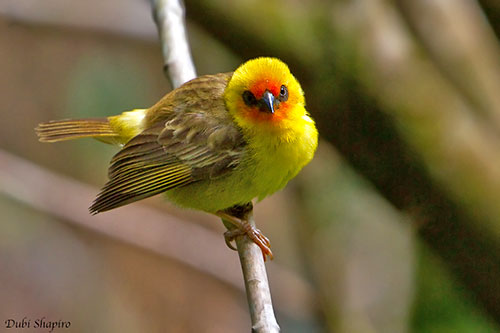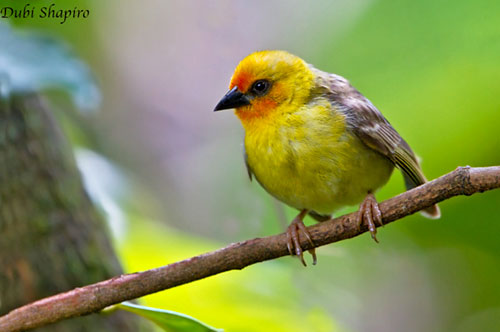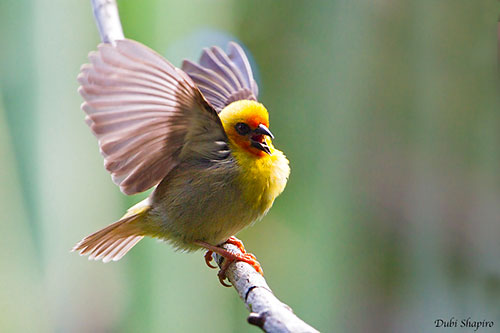
REPRODUCTION OF THIS SPECIES:
The breeding season is recorded in all months, with peak in early summer (September/November) and reduced egg-laying in winter (April/August). This species is monogamous and the pair defends the territory all year-round.
The globular nest is oval with short porch and side entrance. It is made with woven grass, flexible twigs and rootlets. The cup is lined with some feathers. It is placed at the end of a branch, between 1,5 and 4,5 metres above the ground, often in Araucaria tree.
The female lays 3 pale blue eggs and incubates alone during 13-16 days (in captivity). Both parents feed the chicks with live food carried in the bill or by regurgitation. The young fledge two weeks after hatching.
PROTECTION / THREATS / STATUS:
The Rodrigues Fody was heavily threatened by the 1970s by habitat loss, competition with the introduced Red Fody, cyclones and droughts, and the population suffered huge decline.
But the species is now recovering thanks to habitat protection and reforestation, and recent absence of cyclones. The suitable sites are fenced to exclude grazing animals and woodcutters. Native plant species have been replanted.
The population has increased with an average annual growth rate of 8%. The global population is now estimated to number 4,000/8,000 individuals (2013) and it is still increasing, following expansion of forest cover.
The Rodrigues Fody is a restricted-range species and remains vulnerable to stochastic events and introduced species. It is currently listed as Near Threatened.
Fr: Foudi de Rodrigues
Ang: Rodrigues Fody
All: Rodriguezweber
Esp: Fodi de Rodríguez
Ita: Fody di Rodriguez
Nd: Rodrigueswever
Sd: rodriguesfody
Photographer:
Dubi Shapiro
Dubi Shapiro Photo Galleries & Dubi Shapiro's Pictures on IBC
Text by Nicole Bouglouan
Sources:
HANDBOOK OF THE BIRDS OF THE WORLD Vol 15 by Josep del Hoyo-Andrew Elliot-David Christie - Lynx Edicions – ISBN: 9788496553682
The Birds of Africa: Volume VIII: The Malagasy Region: Madagascar, Seychelles, Comoros, Mascarenes - Par Roger Safford, Frank Hawkins – ISBN: 1408190494, 9781408190494- Editeur: A&C Black, 2013
Birds of Madagascar and the Indian Ocean Islands Par Roger Safford, Adrian Skerrett, Frank Hawkins – ISBN: 1472924118, 9781472924117- Editeur: Bloomsbury Publishing, 2015
OISEAUX des ÎLES DE L’OCÉAN INDIEN De Ian Sinclair – Editeur : Penguin Random House South Africa, 2013 – ISBN : 1775840727, 9781775840725 - 263 pages
The weaver bird family - Rodrigues Fody (Foudia flavicans)
Wikipedia, the free encyclopaedia
Family Ploceidae
Page Passeriformes Order
Rodrigues Fody
Foudia flavicans
Passeriformes Order – Ploceidae Family
INTRODUCTION:
The Rodrigues Fody is an arboreal passerine endemic to Rodrigues, an island of Mauritius. It frequents the remnants of native forest, but also exotic plantations and dense shrubs. It feeds on insects, spiders, fruits, seeds and nectar. The species is monogamous and territorial year-round.
The Rodrigues Fody was formerly affected by destruction of native forest, restricted range and very small population. However, the increasing reforestation with both native and exotic tree species involves the increase of the population. Habitat protection to exclude grazing mammals and woodcutters, and replacement of native plant species always contributes to the recovery of this beautiful passerine. But currently, the Rodrigues Fody is listed as Near Threatened.
DESCRIPTION OF THE BIRD:
Biometrics:
Length: 12 cm
Weight: 13-17 g
The Rodrigues Fody male adult in breeding plumage has pale brownish-olive mantle and back with conspicuous blackish central streaks. The rump may vary from brown to yellow. On the brown upperwing, the wing-coverts show buff or yellowish edges. The tail is brown.
On the underparts, lower throat and breast are golden yellow but belly, flanks, thighs and undertail-coverts are mostly buffy white.
Head and nape are golden yellow, whereas the area from forehead to upperthroat is orange. We can see a small black mask on lores and around each eye.
The pointed bill is black. The eyes are brown. Legs and feet are brown.

The non-breeding male keeps the yellow tinge on the face and the black bill.
The adult female (not displayed) is duller. The upperparts are dull olive-brown with narrow blackish central streaks, broader on back. The rump is uniformly olive-brown. Wings and tail are darker with pale-edged wing-coverts. We can see an indistinct greyish-buff supercilium, whereas cheeks and ear-coverts are pale olive-brown.
The underparts are whitish with yellowish wash, but flanks and thighs show mostly buffy wash.
The juvenile resembles female, but it may have some yellow on throat and the bill is paler, usually horn-coloured.
RANGE:
The Rodrigues Fody is found on Rodrigues, in E Mascarene Islands.
HABITAT:
The Rodrigues Fody frequents dense, mature, exotic forest, but this species is mainly found in tall trees and closed canopy. It favours plantations of Araucaria cunninghamii (known as Hoop pine) for nesting. It is rare or absent in Eucalyptus monocultures. The native vegetation, still degraded, may become suitable as rehabilitation is in progress.
CALLS AND SONGS: SOUNDS BY XENO-CANTO
The Rodrigues Fody gives a harsh, frequently repeated “chip”. A “chew” note is given in association with “chip” notes or included into song sequences.
The song includes clear whistles, trills, clicks and scolding notes. It is a long sequence that may split into phrases of 3-10 notes and lasting 30 to 180 seconds. Male and female sing.

BEHAVIOUR IN THE WILD:
The Rodrigues Fody feeds on various insects, spiders, nectar and seeds, and probably fruits.
It frequently feeds on nectar from several plant species. Its brush-tipped tongue allows the bird to access nectar of large flowers such as Tabebuia, Lantana camara and Hibiscus.
It takes seeds on Casuarina equisetifolia by hanging directly from cones. It flies from branch to branch and tree to tree while feeding on cones, gleaning along branches and in canopy. It walks up and down vertical trunks while probing in crevices.
The Rodrigues Fody is observed in pairs or family groups, but it is often alone. It may join mixed-species flocks with Rodrigues Warbler, Red Fody, House Sparrow and Common Waxbill.
This species is very active and vocal during territory defence that occurs year-round. The male often adopts a “wing-drooped” posture even when feeding. The wings are partly open and quivering while the bird gives repeated “chip” calls.
During the breeding season, the male is often seen singing and displaying, performing mainly the “wing-beating” display and alternating with feeding. The female is quieter although she can produce displays, calls and songs but less frequently than the male, and often with her mate rather than alone.
The Rodrigues Fody is resident. The flight is rapid and direct.
